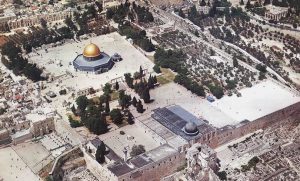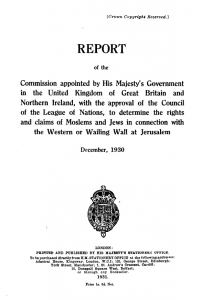The Murabiteen and Murabitat, or Murabitoun, or Murabito Al-Aqsa are groups or individuals from Al-Quds city (Jerusalem) and its surroundings, and [Palestinian] Muslim citizens of the occupied lands in 1948. They devoted themselves and their time to stay at Al Aqsa Mosque to guard its gates and protect it from attacks by “Israeli” soldiers, Jewish extremists, and radical settlers. The Murabiteen represent different generations and various political and cultural backgrounds, their illimitable love of al-Aqsa unites them all together; elderly people, young men, and women besides the students who memorize and recite the Holy Quran and attend the Sharia lessons on al-Aqsa terraces.
Definition of Ribat and its origins in al-Aqsa Mosque
The original meaning of Ribat is to reside in a place without leaving it. In Arabic, “rabata” means, he resides in the same place without leaving. Hence, Ribat is known to reside particularly in the border weak hiatus areas (Thughur), which are threated to be attacked by the enemies, in order to strengthen, protect and defend the Muslims. Ribat has an enormous virtue in Islam, it is one of the forms of jihad for the sake of Allah. The messenger of Allah said, “Observing Ribat for a single day is far better than the world and all that it contains. A place in Jannah as small as the whip of your horse is far better than the world and all that it contains”[1].
Since the first century AH / 7th AD, Muslims have been accustomed to stay at al-Aqsa Mosque, so that a large number have left their homes and migrated to Jerusalem (al-Quds) to perform Itikaf [a retreat inside the mosque for the sole purpose of worship and devotion to Allah] in Al-Aqsa and to be buried after passing away in its vicinity. Probably, the companions Shaddad ibn Ous (64 AH / 683 AD) and Thu al-Asabi’a were the first cited examples of companion who moved to reside adjacent to al-Aqsa Mosque. the companion Thu al-Asabi’a was inspired by the Prophet’s words and moved to live near to al-Aqsa. He said “I asked the Prophet (pbuh), “O Messenger of Allah, if we were to stay somewhere after you, were do you command us?” The Prophet said, “Stay in Bait al-Maqdis so that if you have progenies, they’d go to the mosque”[2] Even after them, Ribat and Itikaf have never stopped in al-Aqsa over the next centuries except the era of the Crusades when the entire mosque was occupied and converted to church and hostel for the Crusader soldiers. The books of history, mysticism, and biographies contain many signs of those who lived in al-Aqsa and devoted themselves for worship and observing Itikaf.
Evolution and Development
The second uprising – Al-Aqsa Intifada– has broken out in 2000 AD after the Zionist prime minister Ariel Sharon stormed al-Aqsa Mosque. Subsequently, the Islamic movement in 1948 occupied lands under the leadership of Sheikh Raed Salah, began to think about the need to protect al-Aqsa Mosque and facilitate the arrival of worshipers all the time to resist the autocratic control by the Israeli occupation forces. Then they have launched what was known as the “March of the Flags (Biarik)” and “Travelling Convoys”, to transport the worshipers daily by buses from Galilee, Triangle (al-Muthallath), Negev and the coast area (al-Sahel) to al-Aqsa Mosque which had direct and positive influence on the revival of al-Aqsa Mosque and on the development of the economic life of the Old City of Jerusalem.
The second phase of Ribat in al-Aqsa was the establishment of the “Science Terraces” (Masatib al-Elm) learning groups (halaqat). Thus, in 2008, the Islamic Movement in the 1948 occupied lands sponsored the establishing of 36 learning groups (halaqa) inside the mosque, teaching the Islamic studies such as; Quranic studies, fiqh, sunnah, and the prophet’s (pbuh) biography through scientific methodological courses which meet the needs of the learners of all ages. Gradually, these halaqat have been increased until the number of their members reached to 1200 students in 2011. Later on, they formed permanent halaqat and showed high interest to attend them to learn and perform ribat inside the mosque. Besides, they defend the mosque, confront the attackers and try to expel them.
2015, was the year of the declared Israeli war against the Murabiteen and Murabitat. On August 23, 2015, the ‘Israeli Intelligence’ issued a list of about 20 women (Murabitat) from Jerusalem. The list increased to include 55 names and it was known among the activists as the “Golden List”, which bans all the listed women from their rights to enter al-Aqsa Mosque and pray there. In the same month, the Zionist war minister, Moshe Ya’alon, issued a decision to designate the Murabiteen and Murabitat as an illegal organization based on the recommendation of the ‘Israeli police’ and the ‘General Security Service’. “Considering them as a major factor in creating tension and violence … and undermining the Israeli sovereignty over al-Aqsa Mosque!” This reflects the arrogance of the Israeli occupation and imposing the status quo despite its contrary to the logic. According to the decision, the presence of Muslim worshipers in their mosque is a factor of tension and violence, while storming al-Aqsa Mosque by soldiers and extremists is not!
Despite the prohibition and criminalization of ribat by the Zionist occupation, the Murabiteen and Murabitat have not stopped their ribat and their continuous presence at the gates of al-Aqsa. In July 2017, they played a significant role in the uprising of the ‘Tribes Gate’ (Bab al-Asbat). They led and guided the demonstrators during the sit-ins at the gates of al-Aqsa. So, the concept of ribat expanded until thousands of people from Jerusalem and the 1948 occupied lands joined them. The sit-in succeeded in breaking the will of the occupation and restoring the situation in al-Aqsa as it was before, and they achieved victory by entering al- Aqsa together with all Muslims without passing through the electronic gates (Metal Sensors) that the occupation wanted to enforce at the gates of al-Aqsa as a new practice to impose its control over al-Aqsa Mosque.
Significance and Role of Murabiteen
Basically, the importance of Ribat is not leaving al-Aqsa Mosque empty of worshipers and visitors, especially in the morning and afternoon or during the Jewish festivals, where the number of intruders and their aggressions increases, and also the number of their attempts to perform Jewish rituals in al-Aqsa. At this time, the role of Murabiteen clearly demonstrates to stop and confront the Jewish intruders and to prevent the imposition of the temporal and spatial division of al-Aqsa Mosque which the occupation seeks to impose it as the status quo in al-Aqsa, just as it happened previously in al-Ibrahimi Mosque in Hebron city. Therefore, the Murabiteen are the frontline defense on behalf of millions of Arabs and Muslims to guard and defend al-Aqsa Mosque.
Ribat in al-Aqsa aims to achieve a permanent Islamic presence to defend and protect it, and to show respect to its holy status. The murabiteen therefore are compelled to leave their jobs and devote themselves to this mission. Some of them make ribat as their permanent work and jihad in al-Aqsa Mosque. They confront the storming by their empty hands and bare chests, as well as their throats that praise and scream in the face of the intruders and aggressors “Allahu Akbar” – Allah is Great -!
In that regard, the murabiteen achieved remarkable results. In addition to obstructing the partition project, they are always in the frontline of defense to confront the occupation and defend the mosque on behalf of the nation (Umma). The Murabiteen and Murabitat have become an icon and a source of inspiration and motivation for many activists around the world because of their steadfastness and determination to keep themselves associated with al-Aqsa Mosque despite the persecution, physical abuse, attacks, and arrests. There are several names among the murabitat who succeeded in transmitting al-Aqsa news and actions. They also conveyed the messages of al-Aqsa through attending the international conferences, public meetings, or using social media sites. Sheikh Raed Salah, who devoted his life, time, and effort to al-Aqsa is considered as the leader of the murabiteen. There are many others of murabiteen such as Sheikh Kamal al-Khatib and other leaders of the Islamic Movement, as well as the murabitat such as; Khadija Khois, Hanadi Halawani, Zina Amro, Sahar al-Natsheh, Samiha Shaheen, um-Ihab al-Jallad, and many others whose their experience is illustrated in Aqsapedia.
Zionists Targeting the Murabteen
The brutality of the Zionists in targeting the murabiteen has been increased because of their growing role of defending al-Aqsa and obstructing the division plans. They were subject to various types of war against them such as the following actions;
1) Banning ribat and consider it illegal
On August 23, 2015, the Zionist war minister, Moshe Ya’alon, issued a decision to designate the Murabiteen and Murabitat as an illegal organization based on the recommendation of the ‘Israeli police’ and the ‘General Security Service’. “Considering them as a major factor in creating tension and violence … and undermining the Israeli sovereignty over al-Aqsa Mosque!” This reflects the arrogance of the Israeli occupation and imposing the status quo despite its contrary to the logic. According to the decision, the presence of Muslim worshipers in their mosque is a factor of tension and violence, while storming al-Aqsa Mosque by the soldiers and extremists is not!
2) Deporting Murabiteen outside al-Aqsa Mosque
It is a relentless action applied by the Israeli occupation police against the murabiteen and murabitat, which deprives them from their right to enter al-Aqsa and perform worship. The ban was imposed on dozens of them. For example, on August 23, 2015, the ‘Israeli Intelligence’ issued a list of about 20 women (Murabitat) from Jerusalem. The list increased to include 55 names and it was known among the activists as the “Golden List”, which bans all the listed women from their rights to enter al-Aqsa Mosque and pray there. Despite the ban and criminalization of ribat by the occupation, the Murabiteen and Murabitat continued their ribat and their continuous presence at the gates of al-Aqsa.
(For more on the Golden List click here: ‘Golden List’ is a turning point in the history of al-Aqsa Mosque)
3) Banning ‘Travelling Convoys’ to al-Aqsa
The decision to ban Rabat was accompanied by the Zionist occupation’s war against the ‘Travelling Convoys’ (buses carrying the worshipers from the 1948 Palestinian occupied lands to al-Aqsa Mosque). They stopped the buses and prevented them from reaching al-Aqsa Mosque, and threatened the drivers to impose high fines if they transport the worshipers. Their aim is preventing the murabiteen from reaching al-Aqsa mosque.
4) Arrest and trial
5) Deporting Murabiteen outside Al-Quds city and banning them.
6) Banning travel and revocation of residency status.
7) Arresting Murabiteen and accusing them of chanting “Allah Akbar” in the face of the radicals Jewish who storm al-Aqsa.
8) Summoning Murabiteen for repeated interrogation in a harmful way.
9) Arbitrary detention of Murabiteen for days without a charge.
10) Verbal and physical assaults against Murabiteen such as; swearing, beating, and torturing.
11) Holding Murabiteen’s IDs.
12) Storming Murabiteen’s houses.
13) Preventing medical insurance coverage for Murabiteen and their families.
14) Threatening to take Murabiteen’s children and sending them to orphanages.
15) Placing Murabiteen under the house arrest.
16) Imposing financial penalties on Murabiteen.

